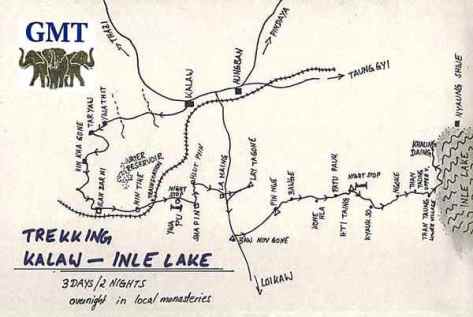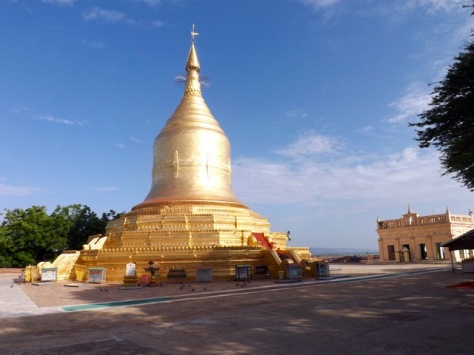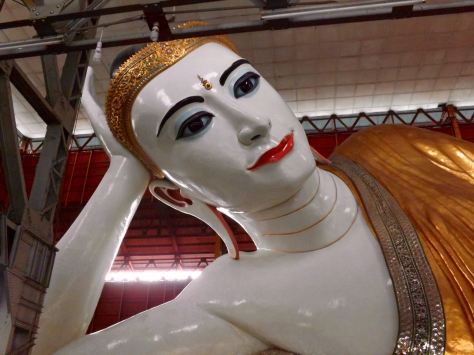Most hikes to Inle Lake start at Kalaw, a township about an hour west of Inle Lake. Most buses stop at Kalaw on the way through dropping off tourists to do the hike. The tour company will take your pack and arrange for it to be waiting for you at your hotel at the other end.
But, if you’re like me and don’t like the idea of handing over your Macbook and other electronics to a random stranger hoping it will all appear at the other end, then the bus continues on to Nyaung Shwe, the main tourist town of Inle Lake. Once there you can find your hotel and make arrangements to have your things put in a locker before arranging a bus back to Kalaw.

There are plenty of trekking guides in Kalaw but for some reason I was drawn past all the others to Sam’s Family Restaurant and Trekking. They gave me the options of different lengths of trek, from 1 to 3 days and the prices depending on number of people in the group, from 1 to 6 people. Of course, the more the people, the lower the price.
You are then asked to come back the night before the trek to meet the others in your group. With group treks it’s important to get the right group. The group I was to go with seemed nice people and were from all across Europe. We were given a vague trek plan and shown our route on a map. Here is a vague approximation of the route although ours was slightly different.

Day 1
It had rained overnight, which didn’t bode well for the trek. On top of that, as my room at the guesthouse was above the kitchen, I was awakened at 4.30am by someone messing around with pots and pans. Then, as if to ensure I had no hope of getting back to sleep, the water pump beside the kitchen started. At least the rain had stopped.
After breakfast, I headed down to Sam’s Family Restaurant at the allotted 8.30am time to get ready for the trek. But when I got there I found that I’d been put into a different group. My new group did not seem as friendly as the other and contained three Israelis and two French girls.
We began walking through the streets of Kalaw, avoiding motorbikes as we went. We then headed out onto a dirt road through houses with plentiful flower gardens.

I stopped to take photos as the rest of the group chatted away. This was when the realisation hit me that my five hiking companions were all talkers. So, I hung out at the back to try to enjoy the sounds of nature without having to listen to the constant dribble of human voices. This is, after all, why I started hiking alone all that time ago.

Finally, after a short time we left the sound of engines and motorbikes behind and started out along a dirt trail. The track led us through an evergreen forest for an hour with several short climbs.

As we went we passed a couple of rice paddies hidden among the trees.

After an hour in the forest we arrived at a reservoir where we stopped to rest and watch some locals fishing.

After our rest and a banana, we headed back into the forest for forty-five minutes with more climbing, although nothing too strenuous. We eventually reached a view-point high on the side of the hill above a green tea plantation.

Ten minutes further on we stopped at a Nepali Restaurant which allowed more great views while we ate our vegetarian curries. After sitting briefly with my group, I discovered they preferred to chat together in their own languages. As I was the only native english speaker I decided to sit with my original group who were more willing to talk in a common language.

After lunch we walked further along the ridge until we met a group of local ladies from the Paung tribe of the Hin Kai Kung village who were heading to work in the tea plantation. They were more than happy to pose for some photos with us.

We walked around the end of the valley following a dirt road and came through their village nestled high on the hilltop opposite our viewpoint lunch spot.

Once past the village, we descended downhill on the dirt road for nearly an hour. I was enjoying being out in nature again after so long and as I had for most of the day I dropped back far enough that I could barely hear the ongoing loud chatter of my group.

We again passed several paddy fields on the way to the railway line. We then walked along the sleepers for forty minutes, not worried about oncoming trains as they move so slowly there would have been plenty of time to get out of the way.
We then stopped for a 15-minute break in the disused railway station of the Nyin Dirk village of the Daung people, which is now a cafe type eatery. After the rest we walked on through paddy fields towards our stopping point.

With about an hour to go the sky opened up and it poured on us. This left us with a muddy climb through hills.

This made the last part of the day longer and harder. Soaked through we eventually made it to the Sat Sky Kong village of the Daung Tribe where we were able to put our packs down and change into dry clothing. I grabbed a beer from the local store before dinner, which was amazing, several different plates with curries and other vegetable dishes, all with rice. After dinner, we hung out in the kitchen with our guide, the cook and two of the owners, drinking the local Myanmar rum. Then we sunk into a sleep at around 9.30pm.
Day 2
The roosters began at 5.00am but only for ten minutes before falling silent again. We continued to doze until 7am when breakfast was brought into our room consisting of french toast, fruit and coffee. I learned that the french call french toast ‘toast’ although Paen Perdu better describes what we know.
After breakfast we prepared to leave, stopping for some of the group to buy fresh water at the store while the rest of us looked out over the village paddy fields.

We headed out of the Sat Sky Kong village around 8.30am on a wide dirt road, with some puddles.

As we walked, we noted the plentiful paddy fields were in many stages of being planted. Some were being tilled and it was from this we learned the value of buffalo to these people. They can be a cheaper, self-sustaining but much slower version of the motorbike.

But for the most part it is the strength of the buffalo that is treasured. A single buffalo can till a field quickly and easily while would take two oxen to do the same work in slower time. Buffalos are not cheap, each costing about US$2,500, so they are well looked after and usually not eaten. Here the farmer is giving his buffalo a bath and by the sounds coming from the buffalo, it was enjoying it immensely.

After two and a half hours of walking we stopped for a green tea break in the Kyatsu village of the Baro tribe. Then it was off again along the dirt road through more paddy fields. After talking constantly and loudly throughout the first part of the day causing me to drop back again to be able to hear nature, the Israelis seemed to run out of things to talk about and decided to listen to music instead, singing along for the rest of the day.

While it did not rain before lunch there was a low haze over the mountains. There is a sense of mystery about a landscape cloaked in clouds.

We arrived in the Nan Dhin village of the Daung Yo tribe for lunch at a cafe-like eatery. There were two other groups there already, the group I had almost begun with and another I had not met before. I hung out with the french girls in my group and chatted as we ate.
It poured during lunch but thankfully the store sold rain ponchos. While I have a jacket it no longer resists the rain, as I learned during the last hour of day one. The rain poncho was too long, so I cut it down to a better size. This amused the staff although they were even more amused when several other members of the groups bought and cut down their ponchos as well. But as soon as we set out after lunch the rain stopped. We followed a red dirt road across more fields, the Israelis singing away loudly to the amusement of any locals we came across.

Beyond stopping for an occasional five-minute break here and there, we did not take an afternoon break but plodded along the red dirt road towards the low mountains in the distance, passing small settlements and people working in the fields.

About an hour before we were due to stop for the day we finally left the road and headed across some muddy tracks through paddy fields. It was around then that it began sporadically raining which caused the mud to be, well, more muddy. This put a damper on the last part of the day and made the mud sticky and heavy on tired legs.

By the time we reached the Partu Park village of the Daung Th tribe most of us were over the day. We just wanted to get to the room, put our packs down, take our boots off and get a beer. So that was pretty much what we did. The other group had arrived before we had, so I joked around with them a little. Then over dinner, a fish curry and vegetables, the Israelis went off into a discussion in hebrew, the french girls went off in a discussion in french and I was left to myself. So, tired after the day I went to bed.
Day 3
At breakfast the discussion again split into the three language groups. This brought me to a decision to ask to walk with the other group. With several european nationalities among them including Denmark, Holland, Spain and Belgium they predominantly spoke in the common english language.

Hiking with a friendly and inclusive group makes a lot of difference. This and the fact that much of the day was spent walking along trails through the mountains instead of dirt roads led me to regard day three the best day of the hike.

We stopped briefly at another Kyatsu village for the Baro tribe before starting our descent towards the plateau where Inle Lake resides.

We passed the Inle Region checkpoint where we had to pay US$10, but as I had already got a ticket on my initial visit I did not have to pay again. We stopped for a longer green tea break at the Nan Yart village of the Baro tribe where we saw two other groups that we had not seen before.
Then after the break we headed further down the valley to the first views of the lake.

Along the way we passed this tree, a cousin to the Bodhi tree, the enlightened tree from India the buddha would sit under. This one is over one hundred and fifty years old.

Then we headed through the pass to the plateau with views of the Inle Lake.

We stopped for lunch at the Donenay village of the Innthar tribe where my original group was also having lunch. I sat with the group I’d walked with on day three and rested for thirty minutes before a ten minute walk to the boats that would take us across Inle Lake to the township of Nyaung Shwe.

During the first part of the hour-long trip across the lake we saw fishermen laying nets and steering their boats with their feet.

With the occasional boat similar to ours racing past.

And mountains on both sides covered in ominous rain clouds.

During the last half of the boat ride those ominous clouds opened up and it poured with rain, so we donned our cut-down ponchos until we were delivered to the jetty.
That evening I met up with my group from day 3 for pizza, european food after days of local food. I had the Tutti Pizza, which I call the ‘Monk Pizza’… one with everything.
Overall, other than ending up with the wrong group, the trek was not bad. The last day was definitely the highlight although the surroundings for most of the trek were amazing. It was great to be out in nature again as it’s been 18 months since my last hike which was to Ciudad Perdida in the Jungles of Northern Colombia.
Then with a heavily blistered foot and a little toe with an infection, I hung out in Nyaung Shwe for a couple of days before heading north to Mandalay.
The Lone Trail Wanderer






























